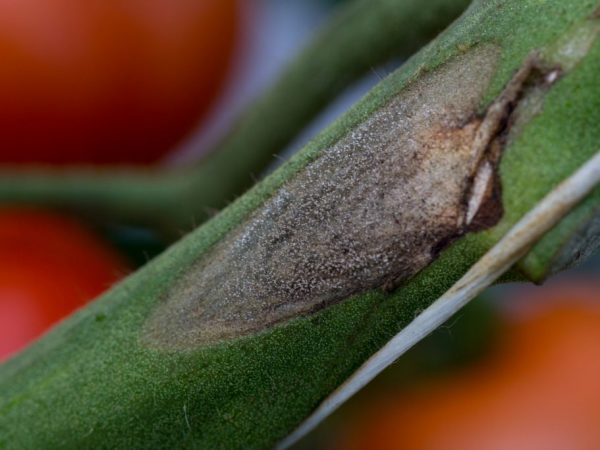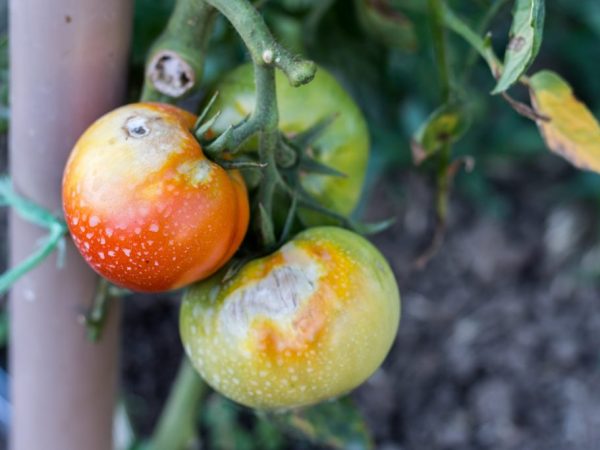Prevention and treatment of gray rot on tomatoes
A lot of trouble for gardeners when growing tomatoes is delivered by gray rot on tomatoes. Photos of summer residents act as a visual demonstration of how damaged plants look, and measures to prevent this disease not taken in time lead to economic losses in the garden.

Prevention and treatment of gray rot on tomatoes
Source of disease and contributing factors
The causative agent of gray rot on tomatoes is the fungus Botrytis cinerea Pers, which infects vegetables outdoors and grown in closed greenhouses. Transmitted mainly by air, during the collection of vegetables and in the process of moving from one bush to another, gray rot on tomatoes leads to wilting and death of the plant. Among the provoking factors that contribute to the emergence and development:
- excessive moisture
- exceeding the norms for the content of nitrogen components in the soil.
Reviews of experienced gardeners, among other conditions that cause the appearance of gray rot on tomatoes, note:
- violation of the composition of the soil, when, in the absence of proper sterilization, the causative agent of the disease, fungal spores, remains, which can provoke infection of a vegetable crop en masse in the greenhouse,
- planting untested tomato seeds,
- violation of the order of moisture in the greenhouse, leading to the accumulation of excessive moisture, and vice versa, insufficient watering of plants, leading to weakening of tomatoes and a decrease in their resistance to disease.
By spraying conidial plaque, fungal conidia are transferred with water when irrigated. The dense sclerotia formed at the end of the gardening season on plant residues ensure that the pathogen remains in the soil for a long time.
Among the main sources most susceptible to disease, from which tomato infestation occurs, are cucumbers, lettuce and others.
Rot symptoms
Among the main signs indicating the presence of rot on tomatoes:
- foci of rotting on fruits of a gray-brown color with a visible fluffy gray bloom,
- spots in areas around the attachment of leaves and tomato brushes,
- tomato stems affected around the perimeter.
The most common gray rot of tomatoes is during the period of fruit ripening. Simultaneously with the stems injured by the fungal disease, which suffer in the first place, without taking measures against it, the infection spreads to the top of the shoots, inflorescences and the vegetables themselves. As a result, if left untreated and controlled, the fungus spreads rapidly throughout the greenhouse. To get acquainted with the characteristic signs and type of damaged tomatoes, take photos of summer residents who are faced with this disease.
Vegetables found affected by rot are immediately harvested and destroyed in order to avoid the spread of fungal disease.
A fungal disease grows in 3-5 days, covering the stems with spots.A little later, the spots become pale to straw shades, turning into blurred stripes. The first week on the very hearth there is no sporulation of the rot fungus. The necrosis developing inside the stem leads to an obstruction of the supply of water through the affected area, resulting in the death of the vegetable crop. Leaves growing on top of necrotic areas begin to turn yellow and fall off. Together with them, the stem is covered with aerial roots.
Agricultural technology against rot
The modern agricultural industry has developed enough measures for the prevention and treatment of gray rot on tomatoes and other vegetable crops. However, frequent procrastination of preventive measures and their application with a great delay reduce their effectiveness.

It is necessary to take preventive measures in time
Among the main reasons why gardeners are late in taking protection measures is the lack of proper diagnosis of the primary signs of the disease at the initial stage. They are often confused with other plant diseases - didimella, fusarium and other pathogens.
Judging by the reviews of summer residents, agrotechnical measures show the best efficiency in the fight against gray rot.
- Agrotechnical protection of tomatoes against gray rot involves, first of all, planting those varieties of tomatoes that are more resistant to this fungal disease. Although they are resistant, possessing resistance against the fungus of gray rot, vegetable growing does not indicate, among the tolerant hybrids, tomato varieties Pilgrim and Vasilievna are noted.
- The second agrotechnical technique in the fight against gray rot of tomatoes is to ensure the required level of humidity in the greenhouse.
- A third way to help prevent the spread of fungal disease is by carefully handling tomato bushes while removing vegetables and foliage. This involves removing damaged leaves and stems using a sharp knife and only in dry weather. Remnants of removed plants that serve as a source of spread of fungal infection must be destroyed.
- Drip irrigation and covering tomato bushes with mulching materials show great efficiency in the fight against gray rot when growing tomatoes.
Among the agrotechnical measures to protect tomatoes from gray rot is the treatment of plants at the vegetative stage of development. This is done with sodium humate. The percentage of reduction in the spread and development of gray rot on tomato stems is up to 48-54.
Biology and chemistry against rot fungus
In addition to agrotechnical measures, biological and chemical measures are widely used in the fight against fungus and in the treatment of tomatoes against gray rot.
Biological techniques
They involve the treatment of tomato stems, which must be treated with a trichodermine suspension. This is done after the breakage of the affected foliage, which stops the appearance of secondary fungal foci. Together with trichodermin, it helps to fight and shows itself well as a biological protection against gray rot on tomatoes, glyocladin, which is smeared with weeping places. Such laborious methods of fighting gray mold show good results with long-term effectiveness. With the help of these biological suspensions, you can spray tomato bushes, doing this in the daytime, allowing the plant to dry before the evening coolness.
Chemicals
Prevention and treatment of the disease can be done with chemical preparations - fungicides. During the growing season, when signs of disease are detected on tomatoes, the stems and leaves of plants are coated with fungicidal preparations. In advanced cases, it is recommended to spray tomato bushes with fungicides in a continuous way, which prevent the intensive spread of the fungus in the greenhouse and allow you to save the crop.
Reviews of gardeners are advised to adhere to the schedule for processing tomatoes with fungicides:
- in May, make a mandatory coating and spray the identified affected areas with drugs,
- repeat the treatment after 2 weeks,
- in June - July, make coatings of damaged areas, in the second half of August, when the disease spreads, treat tomatoes with preparations in a continuous way,
- re-process at the beginning of September.
Prevention of tomato protection also involves treating the soil with drugs and steaming the substrates, and disinsecting greenhouse structures.


